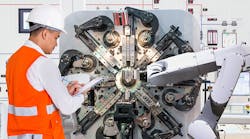In 1993, I saw the future.
It was in Japan. At the foot of Mt. Fuji, to be exact. I was on a two-year assignment as a National Science Foundation fellow in Tsukuba, Japan, and I’d arranged a tour of Fanuc’s “lights-out” plant: the one where robots make more robots.
I left that tour convinced I’d glimpsed the future of manufacturing: that humanity was on the path to transcending plant labor. I thanked my lucky stars I’d chosen to go into robotics. A year later, I parlayed my passion into a role leading the industry/university team at General Motors that developed the world’s first cobots: robots that work closely with humans, combining the best of both, now predicted by Barclays investment bank to be a $12 billion market by 2025.
25 years later, Fanuc’s lights-out plant is still going strong. But…in just about every other plant, humans remain dominant.
The robot revolution has yet to arrive.
According to research from the Boston Consulting Group, robots perform about 10% of tasks in a typical factory. They expect that number to rise to 25% by 2025—a fast growth pace, but hardly enough to lead to human obsolescence in manufacturing.
Human beings—good old flesh and blood—are the primary creator of value inside the factory, and will remain that way for many years.
This despite the almost daily headlines that proclaim robots are extending their dominion over one facet of humanity or another. According to the headlines from April alone, humans are slated to be obsolete in retail, food delivery, assembling Ikea furniture, and student counseling.
I no longer believe these predictions. I don’t expect the role of humans to materially change inside the factory any time soon.
Betting on People
“The greatest value a human adds to a process is the ability to cope with the unexpected, the edge cases,” says Michael Peshkin, professor of mechanical engineering at Northwestern University. Peshkin and colleague Ed Colgate invented cobots as part of the GM/university collaboration.
“A human, for example, could very easily notice that some out-of-position wires are interfering in an assembly, and brush them away to continue the work. A machine, on the other hand, would have great difficulty even recognizing the wires, and just as much difficulty in pushing them out of the way. Unlike humans, robots can generally only cope with problems that were predicted for them.”
Agility and judgment, then, are among the chief advantages that humans possess in the factory. Despite decades of advances in robotics and, more recently, AI, no machine comes close.
But humans also possess a clear disadvantage: variability.
Humans perform inconsistently. They make mistakes. They forget things. They tire. Not to mention that they’re hard to find in times of low unemployment and that their delicate inner workings aren’t protected by a shiny metal shell. And perhaps most significantly, it’s extremely hard to get consistent and reliable data from human activities. Frederick Taylor introduced the time study to the industry in 1911; the technique remains in widespread use, essentially unevolved, to this day.
So why haven’t robots displaced humans yet?
I propose three interrelated hypotheses.
1. The Robot Population Is Growing Too Slowly
Last year, economists Daron Acemoglu and Pascual Restrepo released a study on the impact of robots on the human workforce. They estimated that each new robot replaces 5.6 workers. A few months later, the International Federation of Robotics released projections that the global robot population would increase from 1.8 million in 2016 to 3.0 million by 2020. Combining those two numbers, the 1.2 million new robots coming online should displace 6.7 million jobs.
Without context, that’s a large-sounding number. But context is important. According to Goldman Sachs Research, there are currently more than 340 million global temporary and full-time manufacturing workers.
Take away 6.7 million jobs from 340 million workers, and you still have an extraordinarily large number of human workers.
2. Mass Customization Is Ascendant, and That’s Where Robots Fall Short.
The most ideal situation for a robot is a high-volume situation: one in which the process demands speed and precision, repeated over and over again ad infinitum. But the market is trending in the other direction.
“Auto manufacturers like Daimler provide a great example,” says Anik Bose, general partner at Benhamou Global Ventures.
“Eight to 10 years ago, they may have had 15 models. Today they may have 40 models. Tomorrow they may have 75 models. In this environment, it’s not about capacity—it’s about customization and time-to-market. And this is where workers are far more critical than machines.”
Peshkin agrees. “Automation requires specialized process and product design,” he says. “Maybe future robots will be able to adjust on the fly, but today they still require considerable programming and configuration to cope with change.
“On the other hand, a person is much better suited to cope with customizations or lot sizes of one. People often provide the path of lower resistance.”
3. It Takes a Village To Run a Robot
Behind every productive robot is an army of robot programmers, process engineers, and skilled technicians who made it that way. A robot doesn’t simply show up to work one day—instead, it requires assistance every step of the way, from a redesign of the process to construction on the factory floor to programming and configuration.
None of these skills are easy to come by—especially at a time when Deloitte estimates that 57% of the manufacturing jobs created between 2015 and 2025 will go unfilled due to a lack of skilled workers.
Blogger Alex Owen-Hill articulated it best: “Robotics spans several different fields, including mechanical engineering and computer science. To be effective, applicants need skills like systems analysis, critical thinking, and complex problem-solving. As a result of this, working with robots is a ‘skilled job,’ whereas, in the past, jobs in the same workplace may have been ‘unskilled’. Employers have reported finding it difficult to fill jobs because their applicants don't have the necessary level of technical skill needed to operate the robots.”
So, Don’t Wait for the Robots To Arrive
I return to my colleague Michael Peshkin from the cobots days. “At the time Prasad Akella, Ed Colgate, and I were building cobots at GM, the field of robotics was still focused on autonomy: getting robots to perform what had previously been thought of as uniquely human activities. But we went a different way: using robotics to augment people's work, not replicate or replace it.”
Even as I write this, another fresh cohort of young robotics engineers is likely exiting the Fanuc factory with their eyes dazzling. And while the Fanuc factory is a marvel to behold, my advice to these young men and women who look to the future is to consider a more prosaic alternative: You will go further with a focus on enhancing human advantages than you will by trying to displace them.











